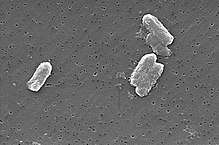Citrobacter freundii
Citrobacter freundii is a species of facultative anaerobic gram-negative bacteria of the family Enterobacteriaceae.[2] The bacteria have a long rod shape with a typical length of 1–5 μm.[3] Most C. freundii cells generally have several flagella used for locomotion, but some do not and are non-motile. C. freundii is a soil organism, but can also be found in water, sewage, food and in the intestinal tracts of animals and humans.[3] The genus Citrobacter was discovered in 1932 by Werkman and Gillen. Cultures of C. freundii were isolated and identified in the same year from soil extracts.[3]
| Citrobacter freundii | |
|---|---|
 | |
| Scientific classification | |
| Kingdom: | Bacteria |
| Phylum: | |
| Class: | |
| Order: | |
| Family: | |
| Genus: | |
| Species: | C. freundii |
| Binomial name | |
| Citrobacter freundii (Braak 1928) Werkman and Gillen 1932[1] | |
C. freundii is a common component of the gut microbiome of healthy humans.[4] While most strains are beneficial, there are significant phenotypic variations among strains, even those that share >99% of their genome.[5] Some rare strains of C. freundii have been associated with opportunistic nosocomial infections of the respiratory tract, urinary tract, blood, and many other normally sterile sites in immunocompromised patients.[6]
C. freundii is also commonly found to be a member of the soil microbiome. This microbe plays an important role in the nitrogen cycle in the environment. C. freundii is responsible for reducing nitrate to nitrite in the environment.[7] This conversion is an important and crucial stage in the nitrogen cycle.
Some members of the species are nitrogen-fixing and have been found in tissues of living sassafras trees.[8]
C. freundii has also been investigated for biodegradation of tannic acid used in tanneries.[7]
C. freundii has the ability to grow on glycerol, and use it as its sole source of carbon and energy. The organism contains a bacterial microcompartment which is capable of processing propanediol. C. freundii creates a positive MR and negative VP test along with a positive Catalase and negative Oxidase test. C. freundii cannot hydrolyze starch, lipids, or gelatin. [9]
References
- LPSN bacterio.net
- "Citrobacter SPP". Pathogen Safety Data Sheet — Infectious Substances. Public Health Agency of Canada. 2012.
- Wang, J. T.; Chang, S. C.; Chen, Y. C.; Luh, K. T. (2000). "Comparison of antimicrobial susceptibility of Citrobacter freundii isolates in two different time periods". Journal of Microbiology, Immunology, and Infection = Wei Mian Yu Gan Ran Za Zhi. 33 (4): 258–262. PMID 11269372.
- Schloissnig, Siegfried; Arumugam, Manimozhiyan; Sunagawa, Shinichi; Mitreva, Makedonka; Tap, Julien; Zhu, Ana; Waller, Alison; Mende, Daniel R.; Kultima, Jens Roat (2013-01-03). "Genomic variation landscape of the human gut microbiome". Nature. 493 (7430): 45–50. doi:10.1038/nature11711. ISSN 0028-0836. PMC 3536929. PMID 23222524.
- Morowitz, Michael J.; Denef, Vincent J.; Costello, Elizabeth K.; Thomas, Brian C.; Poroyko, Valeriy; Relman, David A.; Banfield, Jillian F. (2011-01-18). "Strain-resolved community genomic analysis of gut microbial colonization in a premature infant". Proceedings of the National Academy of Sciences. 108 (3): 1128–1133. doi:10.1073/pnas.1010992108. ISSN 0027-8424. PMC 3024690. PMID 21191099.
- Whalen, J. G.; Mully, T. W.; English, J. C. (2007). "Spontaneous Citrobacter freundii Infection in an Immunocompetent Patient". Archives of Dermatology. 143 (1): 124–125. doi:10.1001/archderm.143.1.124. PMID 17224563.
- Puchenkova, S. G. (1996). "Enterobacteria in areas of water along the Crimean coast". Mikrobiolohichnyi Zhurnal (Kiev, Ukraine : 1993). 58 (2): 3–7. PMID 8983520.
- Line, M. (1990). "Identification of nitrogen-fixing enterobacteria from living Sassafras (Atherosperma moschatum Labill.) trees". Plant and Soil. 125 (Pt 2): 149–152. doi:10.1107/S0907444910050201. PMID 21245529.
- Pang, A.; Warren, M. J.; Pickersgill, R. W. (2011). "Structure of PduT, a trimeric bacterial microcompartment protein with a 4Fe–4S cluster-binding site". Acta Crystallographica Section D. 67 (2): 91–96. doi:10.1107/S0907444910050201. PMID 21245529.
External links
- "Citrobacter freundii". NCBI Taxonomy Browser. 546.
- Type strain of Citrobacter freundii at BacDive - the Bacterial Diversity Metadatabase